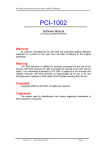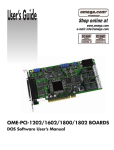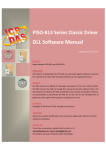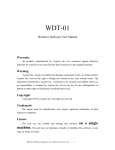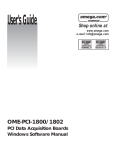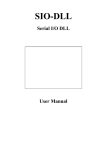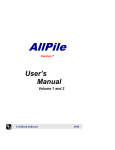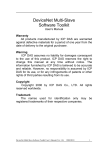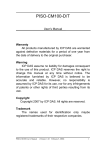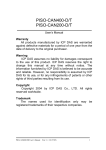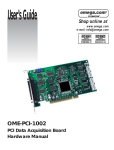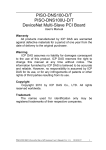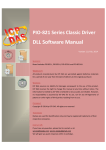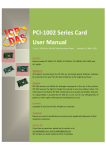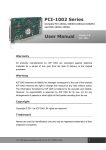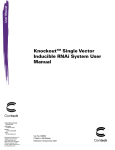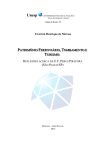Download OME-PCI-1002
Transcript
User’s Guide
Shop online at
www.omega.com
e-mail: info@omega.com
OME-PCI-1002
PCI Data Acquisition Board
Windows Software Manual
OMEGAnet ® Online Service
www.omega.com
Internet e-mail
info@omega.com
Servicing North America:
USA:
ISO 9001 Certified
Canada:
One Omega Drive, P.O. Box 4047
Stamford CT 06907-0047
TEL: (203) 359-1660
e-mail: info@omega.com
976 Bergar
Laval (Quebec) H7L 5A1, Canada
TEL: (514) 856-6928
e-mail: info@omega.ca
FAX: (203) 359-7700
FAX: (514) 856-6886
For immediate technical or application assistance:
USA and Canada: Sales Service: 1-800-826-6342 / 1-800-TC-OMEGA®
Customer Service: 1-800-622-2378 / 1-800-622-BEST®
Engineering Service: 1-800-872-9436 / 1-800-USA-WHEN®
TELEX: 996404 EASYLINK: 62968934 CABLE: OMEGA
Mexico:
En Español: (001) 203-359-7803
FAX: (001) 203-359-7807
e-mail: espanol@omega.com
info@omega.com.mx
Servicing Europe:
Benelux:
Postbus 8034, 1180 LA Amstelveen, The Netherlands
TEL: +31 (0)20 3472121
FAX: +31 (0)20 6434643
Toll Free in Benelux: 0800 0993344
e-mail: sales@omegaeng.nl
Czech Republic:
Frystatska 184, 733 01 Karviná, Czech Republic
TEL: +420 (0)59 6311899
FAX: +420 (0)59 6311114
Toll Free: 0800-1-66342
e-mail: info@omegashop.cz
France:
11, rue Jacques Cartier, 78280 Guyancourt, France
TEL: +33 (0)1 61 37 29 00
FAX: +33 (0)1 30 57 54 27
Toll Free in France: 0800 466 342
e-mail: sales@omega.fr
Germany/Austria: Daimlerstrasse 26, D-75392 Deckenpfronn, Germany
TEL: +49 (0)7056 9398-0
Toll Free in Germany: 0800 639 7678
e-mail: info@omega.de
United Kingdom:
ISO 9002 Certified
FAX: +49 (0)7056 9398-29
One Omega Drive, River Bend Technology Centre
Northbank, Irlam, Manchester
M44 5BD United Kingdom
TEL: +44 (0)161 777 6611
FAX: +44 (0)161 777 6622
Toll Free in United Kingdom: 0800-488-488
e-mail: sales@omega.co.uk
It is the policy of OMEGA to comply with all worldwide safety and EMC/EMI regulations that
apply. OMEGA is constantly pursuing certification of its products to the European New Approach
Directives. OMEGA will add the CE mark to every appropriate device upon certification.
The information contained in this document is believed to be correct, but OMEGA Engineering, Inc. accepts
no liability for any errors it contains, and reserves the right to alter specifications without notice.
WARNING: These products are not designed for use in, and should not be used for, patient-connected applications.
OME-PCI-1002 Software Manual for Windows
Table of Contents
1.
Introduction ........................................................................................................................................4
1.1
Software Installation...................................................................................................................5
1.2
References ..................................................................................................................................7
2. Declaration Files.................................................................................................................................8
2.1
P100X.H .....................................................................................................................................9
2.2
P100Xu.C .................................................................................................................................11
2.3
P100X.BAS ..............................................................................................................................12
2.4
P100Xu.BAS ............................................................................................................................14
2.5
P100X.PAS...............................................................................................................................15
2.6
P100Xu.PAS.............................................................................................................................18
3. Demo Result .....................................................................................................................................19
3.1
Visual C++ ...............................................................................................................................19
3.2
Visual Basic..............................................................................................................................20
3.3
Delphi .......................................................................................................................................21
3.4
Borland C++ Builder ................................................................................................................22
4. Descriptions of Functions.................................................................................................................23
4.1
The Configuration Code Table .................................................................................................25
4.2
The Test Functions ...................................................................................................................26
P100X_FloatSub2.........................................................................................................................26
P100X_ShortSub2 ........................................................................................................................26
4.2.3
P100X_GetDllVersion......................................................................................................27
P100X_GetDriverVersion ............................................................................................................27
4.3
The DI/O Functions ..................................................................................................................28
P100X_Di.....................................................................................................................................28
P100X_Do ....................................................................................................................................28
4.4
The A/D Fixed-mode Functions ...............................................................................................29
P100X_SetChannelConfig............................................................................................................29
4.4.2
P100X_Polling..................................................................................................................30
4.4.3
P100X_AdPolling.............................................................................................................31
4.4.4
P100X_AdsPolling ...........................................................................................................32
4.4.5
P100X_AdsPacer..............................................................................................................33
4.5
Driver Functions.......................................................................................................................34
P100X_DriverInit .........................................................................................................................34
P100X_DriverClose .....................................................................................................................34
4.5.3
P100X_GetConfigAddressSpace......................................................................................35
P100X_WhichBoardActive ..........................................................................................................35
4.5.5
P100X_ActiveBoard.........................................................................................................36
P100X_GetIrqNo..........................................................................................................................36
4.6
The Interrupt Functions ............................................................................................................37
P100X_InstallIrq ..........................................................................................................................37
P100X_GetIntCount .....................................................................................................................37
4.6.3
P100X_INT_AdStart ........................................................................................................38
P100X_INT_AdStop ....................................................................................................................38
4.6.5
P100X_GetBuffer.............................................................................................................39
P100X_GetFloatBuffer.................................................................................................................39
4.6.7
Architecture of Interrupt mode .........................................................................................40
5. Program Architecture .......................................................................................................................44
6. Reporting Problems ..........................................................................................................................45
Page 3
OME-PCI-1002 Software Manual for Windows
1.
Introduction
The OME-PCI-1002 Toolkit is a collection of DLLs and device-driver for
Windows 95/98/NT/2000/XP applications. These DLLs are 32-bit and can be
called by Visual C++, BC++, Visual BASIC, Delphi and LabVIEW.
The OME-PCI-1002 Toolkit consists of the following DLLs and device
driver:
•
•
•
P100X.DLL, P100X.LIB Æ for OME-PCI-1002 card
P100X.VXD Æ OME-PCI-1002 Device driver for Windows 95/98
P100X.SYS Æ OME-PCI-1002 Device driver for Windows
NT/2000/XP
The DLLs perform a variety of tasks including:
•
•
•
•
Read software version
Initialization
Digital Input/Output
A/D conversion
Page 4
OME-PCI-1002 Software Manual for Windows
1.1
Software Installation
Insert the CD ROM included with your OME-PCI-1002 board and the following
installation screen should auto-start.
Follow the instructions on the screen to complete the software installation. The
software is designed to support the entire OME family of data acquisition
hardware, so during the installation, you will be asked to specify your particular
hardware (OME-PCI-1002 board in this case). During the installation process,
you will also be prompted to enter the operating system you will be using.
After installation the following folders will be created on your computer.
Page 5
OME-PCI-1002 Software Manual for Windows
Demo Folder
Contains all demonstration programs including their source code. Examples
are provided for Visual C++, Borland C++, Visual Basic and Delphi.
Please note: The VC++ demos are developed with VC++ 4.0. After setting up
the environment, use the NMAKE.EXE to compiling and linking the demo code.
For Example, C:\P1002\DEMO\VC\nmake /f demo.mak
Driver Folder
Contains software drivers, include files and definition files for the programming
languages.
Manual Folder
Contains hardware user manuals, software user manuals and technical notes.
Diag Folder
Contains card diagnostic programs
Inf Folder
Contains tech notes and .INF file for the plug and play installation (only
available for operating systems that support plug and play).
Page 6
OME-PCI-1002 Software Manual for Windows
1.2
References
Please also refer to the following user manuals:
• SoftInst.pdf:
To install the software package under Windows 95/98/NT/2000/XP.
• CallDll.pdf:
To call the DLL functions with Visual C++, Visual Basic, Delphi and
Borland C++.
• ResCheck.pdf:
To check the card resources, that is, I/O Port address, IRQ number
and DMA under Windows.
Page 7
OME-PCI-1002 Software Manual for Windows
2. Declaration Files
Please refer to user manual "CallDLL.pdf".
|--\Driver
Å some device driver
|
|
|
|--\VB
Å for Visual Basic
|
|
|--\P100X.BAS
Å Declaration file for Visual Basic
|
|
|--\P100Xu.BAS
Å Functions for Visual Basic
|
|
|
|--\VC
Å for Visual C++
|
|
|--\P100X.H
Å Header file
|
|
|--\P100X.LIB
Å Import library for VC only
|
|
|
|--\Delphi
Å for Delphi
|
|
|--\P100X.PAS
Å Declaration file
|
|
|--\P100Xu.PAS
Å Functions for Delphi
|
|
|
|--\BCB
Å for Borland C++ Builder 3.0
|
|--\P100X.H
Å Header file
|
|--\P100Xu.C
Å Functions for BCB
|
|--\P100X.LIB
Å Import library file for BCB only
Page 8
OME-PCI-1002 Software Manual for Windows
2.1
P100X.H
#ifdef __cplusplus
#define EXPORTS extern "C" __declspec (dllimport)
#else
#define EXPORTS
#endif
// return code
#define P100X_NoError
#define P100X_DriverHandleError
#define P100X_DriverCallError
#define P100X_AdControllerError
#define P100X_ConfigCodeError
#define P100X_DriverNoOpen
#define P100X_AdPollingTimeOut
#define P100X_FindBoardError
#define P100X_AdChannelError
#define P100X_DaChannelError
#define P100X_InvalidDelay
10
#define P100X_DelayTimeOut
#define P100X_InvalidData
12
#define P100X_TimeoutError
#define P100X_ExceedBoardNumber
#define P100X_NotFoundBoard
#define P100X_OpenError
#define P100X_FindTwoBoardError
#define P100X_GetIntCountError
#define P100X_InstallIrqError
#define P100X_AllocateMemoryError
0
1
2
3
4
5
6
7
8
9
11
13
14
15
16
17
18
19
20
EXPORTS float
CALLBACK P100X_FloatSub(float fA, float fB);
EXPORTS short
CALLBACK P100X_ShortSub(short nA, short nB);
EXPORTS WORD CALLBACK P100X_GetDllVersion(void);
EXPORTS WORD CALLBACK P100X_DriverInit(WORD *wTotalBoards);
EXPORTS void
CALLBACK P100X_DriverClose(void);
EXPORTS WORD CALLBACK P100X_GetDriverVersion
(WORD *wDriverVersion);
EXPORTS WORD CALLBACK P100X_GetIrqNo( WORD *IrqNo);
EXPORTS WORD CALLBACK P100X_GetConfigAddressSpace
(WORD wBoardNo, WORD *wAddress0,
WORD *wAddress1, WORD *wAddress2);
EXPORTS WORD CALLBACK P100X_ActiveBoard( WORD wBoardNo );
EXPORTS WORD CALLBACK P100X_WhichBoardActive(void);
Page 9
OME-PCI-1002 Software Manual for Windows
EXPORTS void
CALLBACK P100X_SetupTimer
(WORD wChannel, WORD wCoef);
EXPORTS WORD CALLBACK P100X_Delay(WORD wDownCount);
EXPORTS void
CALLBACK P100X_Do(WORD wOutData);
EXPORTS WORD CALLBACK P100X_Di(WORD *wDiData);
EXPORTS WORD CALLBACK P100X_SetChannelConfig
(WORD wAdChannel, WORD wConfig);
EXPORTS WORD CALLBACK P100X_Polling(WORD *wAdVal);
EXPORTS WORD CALLBACK P100X_AdPolling(float *fAdVal);
EXPORTS WORD CALLBACK P100X_AdsPolling
(float fAdVal[], WORD wNum);
EXPORTS WORD CALLBACK P100X_AdsPacer
(float fAdVal[], WORD wNum, WORD wSamplingDiv);
EXPORTS WORD CALLBACK P100X_InstallIrq
(HANDLE *hEvent, DWORD dwCount);
EXPORTS WORD CALLBACK P100X_GetBuffer
(DWORD dwNum, WORD wBuf[]);
EXPORTS WORD CALLBACK P100X_GetFloatBuffer
(DWORD dwNum, float fAdVal[]);
EXPORTS WORD CALLBACK P100X_GetIntCount(DWORD *dwVal);
EXPORTS WORD CALLBACK P100X_INT_AdStart
(WORD Ch, WORD Gain, WORD wFreqDiv);
EXPORTS WORD CALLBACK P100X_INT_AdStop();
Page 10
OME-PCI-1002 Software Manual for Windows
2.2
P100Xu.C
#include <math.h>
//*-----------------------------------------------------*
//* Return voltage value or -100.0 if any error occurs *
//* or parameter is out of range.
*
//* HiLo : 1 --> High Gain , 0 --> Low Gain
*
//* Gain : 0-3
*
//*-----------------------------------------------------*
float P100X_AD2F(Word hex, int HiLo,int Gain )
{
float ZeroBase, VoltageRange, FullRange ;
ZeroBase = 2048.0 ;
FullRange = 2048.0 ;
VoltageRange = 10.0 ;
Gain = Gain % 16 ;
if ( (Gain < 0) || (Gain > 3) )
return -100.0;
if ( HiLo == 0 ) //Low-Gain
return ((((hex - ZeroBase) / FullRange) * VoltageRange) / pow( 2 , Gain));
else
return ((((hex - ZeroBase) / FullRange) * VoltageRange) / pow( 10 ,
Gain));
}
Page 11
OME-PCI-1002 Software Manual for Windows
2.3
P100X.BAS
Attribute VB_Name = "P100X"
' return code
Global Const P100X_NoError
Global Const P100X_DriverHandleError
Global Const P100X_DriverCallError
Global Const P100X_AdControllerError
Global Const P100X_ConfigCodeError
Global Const P100X_DriverNoOpen
Global Const P100X_AdPollingTimeOut
Global Const P100X_FindBoardError
Global Const P100X_AdChannelError
Global Const P100X_DaChannelError
Global Const P100X_InvalidDelay
Global Const P100X_DelayTimeOut
Global Const P100X_InvalidData
= 12
Global Const P100X_TimeoutError
Global Const P100X_ExceedBoardNumber
Global Const P100X_NotFoundBoard
Global Const P100X_OpenError
Global Const P100X_FindTwoBoardError
Global Const P100X_GetIntCountError
Global Const P100X_InstallIrqError
Global Const P100X_AllocateMemoryError
=0
=1
=2
=3
=4
=5
=6
=7
=8
=9
= 10
= 11
= 13
= 14
= 15
= 16
= 17
= 18
= 19
= 20
' Function of Test
Declare Function P100X_FloatSub Lib "P100X.DLL" _
(ByVal fA As Single, ByVal fB As Single) As Single
Declare Function P100X_ShortSub Lib "P100X.DLL" _
(ByVal nA As Integer, ByVal nB As Integer) As Integer
Declare Function P100X_GetDllVersion Lib "P100X.DLL" () As Integer
' Function of Driver
Declare Function P100X_DriverInit Lib "P100X.DLL" _
(wTotalBoards As Integer) As Integer
Declare Sub P100X_DriverClose Lib "P100X.DLL" ()
Declare Function P100X_GetDriverVersion Lib "P100X.DLL" _
(wDriverVersion As Integer) As Integer
Declare Function P100X_GetIrqNo Lib "P100X.DLL" (IrqNo As Integer) _
As Integer
Declare Function P100X_GetConfigAddressSpace Lib "P100X.DLL" _
(ByVal wBoardNo As Integer, wAddrTimer As Integer, _
wAddrDio As Integer, wAddrAd As Integer) As Integer
Declare Function P100X_ActiveBoard Lib "P100X.DLL" _
(ByVal wBoardNo As Integer) As Integer
Declare Function P100X_WhichBoardActive Lib "P100X.DLL" () As Integer
Page 12
OME-PCI-1002 Software Manual for Windows
Declare Sub P100X_SetupTimer Lib "P100X.DLL" _
(ByVal wChannel As Integer, ByVal wCoef As Integer)
Declare Function P100X_Delay Lib "P100X.DLL" _
(ByVal wDownCount As Integer) As Integer
' Function of DI/DO
Declare Sub P100X_Do Lib "P100X.DLL" (ByVal wOutData As Integer)
Declare Function P100X_Di Lib "P100X.DLL" (wDiData As Integer) As Integer
' Function of AD
Declare Function P100X_SetChannelConfig Lib "P100X.DLL" _
(ByVal wAdChannel As Integer, ByVal wConfig As Integer) As Integer
Declare Function P100X_Polling Lib "P100X.DLL" _
(wAdVal As Integer) As Integer
Declare Function P100X_AdPolling Lib "P100X.DLL" _
(fAdVal As Single) As Integer
Declare Function P100X_AdsPolling Lib "P100X.DLL" _
(fAdVal As Single, ByVal wNum As Integer) As Integer
Declare Function P100X_AdsPacer Lib "P100X.DLL" (fAdVal As Single, _
ByVal wNum As Integer, ByVal wSamplingDiv As Integer) As Integer
' Function of Interrupt
Declare Function P100X_InstallIrq Lib "P100X.DLL" _
(hEvent As Long, ByVal dwCount As Long) As Integer
Declare Function P100X_GetBuffer Lib "P100X.DLL" _
(ByVal dwNum As Long, wBuf As Integer) As Integer
Declare Function P100X_GetFloatBuffer Lib "P100X.DLL" _
(ByVal dwNum As Long, fAdVal As Single) As Integer
Declare Function P100X_INT_AdStart Lib "P100X.DLL" _
(ByVal Ch As Integer, ByVal Gain As Integer, _
ByVal wFreqDiv As Integer) As Integer
Declare Function P100X_INT_AdStop Lib "P100X.DLL" () As Integer
Declare Function P100X_GetIntCount Lib "P100X.DLL" (dwVal As Long) _
As Integer
Page 13
OME-PCI-1002 Software Manual for Windows
2.4
P100Xu.BAS
'*-----------------------------------------------------*
'* Return voltage value or -100.0 if any error occurs *
'* or parameter is out of range.
*
'* HiLo : 1 --> High Gain , 0 --> Low Gain
*
'* Gain : 0-3
*
'*-----------------------------------------------------*
Function P100X_AD2F(ByVal hex, HiLo, Gain As Integer) As Single
Dim ZeroBase, BullRange, VoltageRange As Single
ZeroBase = 2048#
FullRange = 2048#
VoltageRange = 10#
Gain = Gain Mod 16
If Gain < 0 Or Gain > 3 Then
P100X_AD2F = -100#
Exit Function
End If
If HiLo = 0 Then 'Low-Gain
P100X_AD2F = ((((hex - ZeroBase) / FullRange) * VoltageRange) / (2 ^
Gain))
Else
P100X_AD2F = ((((hex - ZeroBase) / FullRange) * VoltageRange) / (10 ^
Gain))
End If
End Function
Page 14
OME-PCI-1002 Software Manual for Windows
2.5
P100X.PAS
unit P100X;
interface
type PSingle=^Single;
type PWord=^Word;
const
// return code
P100X_NoError
P100X_DriverHandleError
P100X_DriverCallError
P100X_AdControllerError
P100X_ConfigCodeError
P100X_DriverNoOpen
P100X_AdPollingTimeOut
P100X_FindBoardError
P100X_AdChannelError
P100X_DaChannelError
P100X_InvalidDelay
P100X_DelayTimeOut
P100X_InvalidData
P100X_TimeoutError
P100X_ExceedBoardNumber
P100X_NotFoundBoard
P100X_OpenError
P100X_FindTwoBoardError
P100X_GetIntCountError
P100X_InstallIrqError
P100X_AllocateMemoryError
= 0;
= 1;
= 2;
= 3;
= 4;
= 5;
= 6;
= 7;
= 8;
= 9;
= 10;
= 11;
= 12;
= 13;
= 14;
= 15;
= 16;
= 17;
= 18;
= 19;
= 20;
// Function of Test
function P100X_FloatSub(fA:Single; fB:Single):Single ; stdCall;
function P100X_ShortSub(nA:SmallInt; nB:SmallInt):SmallInt ; stdCall;
function P100X_GetDllVersion:WORD ; stdCall;
Page 15
OME-PCI-1002 Software Manual for Windows
// Function of Driver
function P100X_DriverInit(Var wTotalBoards:Word):WORD ; stdCall;
procedure P100X_DriverClose; stdCall;
function P100X_GetDriverVersion(var wDriverVersion:Word):WORD ; stdCall;
function P100X_GetIrqNo(Var IrqNo:WORD):WORD; StdCall;
function P100X_GetConfigAddressSpace(wBoardNo:Word;
var wAddrTimer:Word; var wAddrDio:Word;
var wAddrAd:Word) :WORD ; stdCall;
function P100X_ActiveBoard(wBoardNo:Word):WORD ; stdCall;
function P100X_WhichBoardActive:WORD ; stdCall;
procedure P100X_SetupTimer(wChannel:Word; wCoef:Word); stdCall;
function P100X_Delay(wDownCount:Word):Word; StdCall;
// Function of DI/DO
procedure P100X_Do(wOutData:Word); stdCall;
function P100X_Di(var wDiData:Word):WORD ; stdCall;
// Function of AD
function P100X_SetChannelConfig
(wAdChannel:Word; wConfig:Word):WORD ; stdCall;
function P100X_Polling(var wAdVal:Word):WORD ; stdCall;
function P100X_AdPolling(var fAdVal:Single):WORD ; stdCall;
function P100X_AdsPolling(fAdVal:PSingle; wNum:Word):WORD ; stdCall;
function P100X_AdsPacer(fAdVal:PSingle; wNum:Word;
wSamplingDiv:Word ):WORD ; stdCall;
// Function of Interrupt
function P100X_InstallIrq
(Var hEvent:LongInt; dwCount: LongInt):WORD ; stdCall;
function P100X_GetBuffer(dwNum:LongInt;wBuf:PWord):WORD ; stdCall;
function P100X_GetFloatBuffer
(dwNum:LongInt; fAdVal:PSingle):Word; StdCall;
function P100X_INT_AdStart
(Ch:WORD; Gain:WORD; wFreqDiv:Word):WORD ; stdCall;
function P100X_INT_AdStop:WORD ; stdCall;
function P100X_GetIntCount(var dwVal:LongInt):WORD ; stdCall;
implementation
function
function
function
function
100X_FloatSub; external 'P100X.DLL' name 'P100X_FloatSub';
100X_ShortSub; external 'P100X.DLL' name 'P100X_ShortSub';
100X_GetDllVersion;
external 'P100X.DLL' name 'P100X_GetDllVersion';
100X_GetDriverVersion;
external 'P100X.DLL' name 'P100X_GetDriverVersion';
Page 16
OME-PCI-1002 Software Manual for Windows
function
procedure
function
100X_DriverInit; external 'P100X.DLL' name 'P100X_DriverInit';
100X_DriverClose;
external 'P100X.DLL'
name 'P100X_DriverClose';
100X_GetIrqNo; external 'P100X.DLL' name 'P100X_GetIrqNo';
100X_GetConfigAddressSpace;
external 'P100X.DLL' name 'P100X_GetConfigAddressSpace';
100X_ActiveBoard;
external 'P100X.DLL'
name 'P100X_ActiveBoard';
100X_WhichBoardActive;
external 'P100X.DLL'
name 'P100X_WhichBoardActive';
100X_SetupTimer;
external 'P100X.DLL'
name 'P100X_SetupTimer';
100X_Delay;
external 'P100X.DLL' name 'P100X_Delay';
procedure
function
P100X_Do;
P100X_Di;
function
P100X_SetChannelConfig;
external 'P100X.DLL'
name 'P100X_SetChannelConfig';
P100X_Polling; external 'P100X.DLL' name 'P100X_Polling';
P100X_AdPolling;
external 'P100X.DLL'
name 'P100X_AdPolling';
P100X_AdsPolling;
external 'P100X.DLL'
name 'P100X_AdsPolling';
function
function
function
function
procedure
function
function
function
function
function
function
function
function
function
function
external 'P100X.DLL' name 'P100X_Do';
external 'P100X.DLL' name 'P100X_Di';
P100X_AdsPacer;
external 'P100X.DLL'
name 'P100X_AdsPacer';
P100X_InstallIrq;
external 'P100X.DLL'
P100X_INT_AdStart;
external 'P100X.DLL'
P100X_INT_AdStop;
external 'P100X.DLL'
P100X_GetIntCount;
external 'P100X.DLL'
P100X_GetBuffer;
external 'P100X.DLL'
P100X_GetFloatBuffer;
external 'P100X.DLL'
name 'P100X_InstallIrq';
name 'P100X_INT_AdStart';
name 'P100X_INT_AdStop';
name 'P100X_GetIntCount';
name 'P100X_GetBuffer';
name 'P100X_GetFloatBuffer';
end.
Page 17
OME-PCI-1002 Software Manual for Windows
2.6
P100Xu.PAS
unit P100Xu;
interface
Function P100X_AD2F(hex, HiLo, Gain :Word): Single ; StdCall;
implementation
uses math;
//*-----------------------------------------------------*
//* Return voltage value or -100.0 if any error occurs *
//* or parameter is out of range.
*
//* HiLo : 1 --> High Gain , 0 --> Low Gain
*
//* Gain : 0-3
*
//*-----------------------------------------------------*
Function P100X_AD2F(hex, HiLo, Gain :Word): Single ;
Var
ZeroBase, VoltageRange, FullRange : Single ;
Begin
ZeroBase := 2048;
FullRange := 2048;
VoltageRange := 10;
Gain := Gain mod 16;
If (Gain < 0) Or (Gain > 3) Then
begin
P100X_AD2F := -100;
exit;
end ;
If HiLo = 0 Then //Low-Gain
Result := ((((hex - ZeroBase) / FullRange) * VoltageRange) / Power(2,
Gain))
Else
Result := ((((hex - ZeroBase) / FullRange) * VoltageRange) /
Power(10,Gain));
End;
end.
Page 18
OME-PCI-1002 Software Manual for Windows
3. Demo Result
3.1
Visual C++
Analog Input with polling demo program
Digital I/O with MFC demo program
Page 19
OME-PCI-1002 Software Manual for Windows
3.2
Visual Basic
Digital I/O demo program
Analog Input with pacer-trigger demo program
Page 20
OME-PCI-1002 Software Manual for Windows
3.3
Delphi
Digital I/O demo program
Analog Input with Interrupt demo program
Page 21
OME-PCI-1002 Software Manual for Windows
3.4
Borland C++ Builder
Digital I/O demo program
Analog input with polling demo program
Page 22
OME-PCI-1002 Software Manual for Windows
4. Descriptions of Functions
The DLL functions are divided into the following groups:
z Test Functions
z D/I/O Functions
z A/D Fixed-mode Functions
z Driver Functions
z Interrupt Functions
Test Functions:
1. P100X_FloatSub2
2. P100X_ShortSub2
3. P100X_GetDllVersion
4. P100X_GetDriverVersion
D/I/O Functions
1. P100X_DI
2. P100X_DO
A/D Fixed-mode Functions:
1. P100X_SetChannelConfig
2. P100X_Polling
3. P100X_AdPolling
4. P100X_AdsPolling
5. P100X_AdsPacer
Driver Functions:
1. P100X_DriverInit
2. P100X_DriverClose
3. P100X_GetConfigAddressSpace
4. P100X_WhichBoardActive
5. P100X_ActiveBoard
6. P100X_GetIrqNo
Page 23
OME-PCI-1002 Software Manual for Windows
Interrupt Functions:
1. P100X_InstallIrq
2. P100X_INT_AdStart
3. P100X_INT_AdStop
4. P100X_GetIntCount
5. P100X_GetBuffer
6. P100X_GetFloatBuffer
The following keywords are used to describe the attributes of function
parameters.
Keyword
Parameter set by user
Data/value available from
before calling function?
this parameter after calling
function?
[Input]
Yes
No
[Output]
No
Yes
[Input, Output]
Yes
Yes
Page 24
OME-PCI-1002 Software Manual for Windows
4.1
The Configuration Code Table
OME-PCI-1002L Configuration Code Table
Gain
1
2
4
8
Bipolar
+/- 10V
+/- 5.0V
+/- 2.5V
+/- 1.25V
Max. Switching Frequency
110 K/S
110 K/S
110 K/S
110 K/S
Configuration Code
0x00
0x01
0x02
0x03
OME-PCI-1002H Configuration Code Table
Gain
1
10
100
1000
Bipolar
+/- 10V
+/- 1.0V
+/- 0.1V
+/- 0.01V
Max. Switching Frequency
44 K/S
36 K/S
7 K/S
0.8 K/S
Page 25
Configuration Code
0x10
0x11
0x12
0x13
OME-PCI-1002 Software Manual for Windows
4.2
The Test Functions
4.2.1
P100X_FloatSub2
z
•
Description:
Calculates C = fA - fB in float format, float=4 bytes floating point
number. This function is provided to test DLL linkage.
Syntax:
float P100X_FloatSub2(float fA, float fB);
z
Parameter:
fA
: [Input] 4 bytes floating point value
fB
: [Input] 4 bytes floating point value
z
Return:
Returns the result value (= fA - fB).
4.2.2
z
•
P100X_ShortSub2
Description :
Calculates C = nA - nB in SHORT formats, SHORT=16 bits signed
number. This function is provided to test DLL linkage.
Syntax :
short P100X_ShortSub2(Short nA, Short nB);
z
Parameter:
nA
: [Input] 16-bit value
nB
: [Input] 16-bit value
z
Return:
Returns the result value (= nA - nB).
Page 26
OME-PCI-1002 Software Manual for Windows
4.2.3
P100X_GetDllVersion
z
Description :
Reads the DLL version of the P100X.DLL.
z
Syntax :
WORD P100X_GetDllVersion(void);
z
Parameter:
None
z
Return:
Returns the version of the DLL for Device-Driver.
return=0x200 Æ Version 2.0
4.2.4
P100X_GetDriverVersion
z
Description :
This subroutine will read the software version of the P100X.VxD for
Windows 95 or P100X.SYS of Windows NT/2000/XP.
z
Syntax :
WORD P100X_GetDriverVersion(WORD *wDriverVersion);
z
Parameter:
wDriverVersion
z
: [Output] address of wDriverVersion,
which contains the version of Device-Driver.
wDriverVersion=0x200 Æ Version 2.0
Return:
P100X_NoError
P100X_DriverHandleError
P100X_DriverCallError
: OK
: P100X.VxD open error for Windows 95
P100X.SYS open error for Windows
NT/2000/XP
: call P100X.VxD return error
call P100X.SYS return error
Page 27
OME-PCI-1002 Software Manual for Windows
4.3
The DI/O Functions
4.3.1
P100X_Di
z
Description :
This subroutine will read the 16 bit data from the DI(digital input)
port. This function addresses the current active OME-PCI-1002 board.
Use the P100X_ActiveBoard(….) to select the active board.
z
Syntax :
WORD P100X_Di(WORD *wDi);
z
Parameter:
wDi
z
: [Output] address of wDi,
which contains the 16 bits of digital input data .
Return:
P100X_NoError
: OK
P100X_FindBoardError
: cannot find the OME-PCI-100X board
P100X_ExceedBoardNumber : invalid board number
4.3.2
P100X_Do
z
Description :
This subroutine will write the 16 bit data to the DO(digital output)
port. This function addresses the current active OME-PCI-1002 board. Use
the P100X_ActiveBoard(….) to select the active board.
z
Syntax :
WORD P100X_Do(WORD wDo);
z
Parameter:
wDo
z
: [Input] the 16-bit data sent to the digital-output port
Return:
P100X_NoError
P100X_ExceedBoardNumber
P100X_FindBoardError
: OK
: invalid board number
: cannot find OME-PCI-1002 board
Page 28
OME-PCI-1002 Software Manual for Windows
4.4
The A/D Fixed-mode Functions
4.4.1
P100X_SetChannelConfig
z Description :
This function will set the A/D channel configuration code. This
function will also set the active A/D channel for P100X_AdPolling,
P100X_AdsPolling and P100X_AdsPacer functions. The function
addresses the current active OME-PCI-1002 board. Use the
P100X_ActiveBoard(….) to select the active board.
z
Syntax :
WORD P100X_SetChannelConfig(WORD wChannel, WORD wConfig);
z
Parameter:
wChannel
wConfig
z
: [Input] A/D channel number
: [Input] Configuration code. Refer to Sec. 3.1 for details.
Return:
P100X_NoError
: OK
P100X_ExceedBoardNumber : invalid board number
P100X_FindBoardError
: can not find the OME-PCI-1002 board
P100X_AdControllerError
: MagicScan controller
hardware handshake error
Page 29
OME-PCI-1002 Software Manual for Windows
4.4.2
P100X_Polling
z
Description :
Performs a single A/D conversion on the active channel by software
polling. The P100X_SetChannelConfig subroutine can be used to
change the channel or configuration code. Use the
P100X_ActiveBoard(….) to select the active board.
z
Syntax :
WORD P100X_Polling(word *wAdVal);
z
Parameter:
wAdVal
z
: [Output] address of wAdVal, which contains the A/D data
Data is returned as an integer value in the range 0-4095.
Return:
P100X_NoError
: OK
P100X_ExceedBoardNumber : invalid board number
P100X_FindBoardError
: can not find the OME-PCI-1002 board
P100X_AdPollingTimeOut
: hardware timeout error
Page 30
OME-PCI-1002 Software Manual for Windows
4.4.3
P100X_AdPolling
z
Description :
This subroutine will perform a single A/D conversion by polling The
P100X_SetChannelConfig function can be used to change the channel or
configuration code. This function addresses the current active OME-PCI1002 board. Use the P100X_ActiveBoard(….) function to select the active
board.
z
Syntax :
WORD P100X_AdPolling(float *fAdVal);
z
Parameter:
fAdVal
z
: [Output] address of fAdVal, which contains the AD data.
The data is automatically converted to voltage based on the
settings of P100X_SetChannelConfig().
Return:
P100X_NoError
: OK
P100X_ExceedBoardNumber : invalid board number
P100X_FindBoardError
: cannot find the OME-PCI-1002 board
P100X_AdPollingTimeOut
: hardware timeout error
Page 31
OME-PCI-1002 Software Manual for Windows
4.4.4
P100X_AdsPolling
• Description :
Performs multiple A/D conversions on a single channel by polling.
The P100X_SetChannelConfig subroutine can be used to change the
channel or configuration code. This function addresses the current active
OME-PCI-1002 board. Use P100X_ActiveBoard(….) to select the active
board.
Since software polling can be interrupted by the operating system,
the P100X_AdsPacer function is recommended when precisely
reconstructing the waveform is desired.
•
Syntax :
WORD P100X_AdsPolling(float fAdVal[], WORD wNum);
•
Parameter:
fAdVal : [Output] starting address of the A/D data buffer(Array of float)
The data is converted to voltage based on the setting of the
P100X_SetChannelConfig() function.
The user must allocate sufficient space for the buffer. The
user can access the data after calling the function.
wNum
•
: [Input] number of A/D conversions to be performed.
Return:
P100X_NoError
P100X_ExceedBoardNumber
P100X_FindBoardError
P100X_AdPollingTimeOut
: OK
: Invalid board number
: Can not find the OME-PCI-1002 board
: Hardware timeout error
Page 32
OME-PCI-1002 Software Manual for Windows
4.4.5
P100X_AdsPacer
z
Description :
This function performs multiple A/D conversions on a single channel
by pacer trigger. The P100X_SetChannelConfig function can be used to
change the channel or configuration code. The function addresses the
current active OME-PCI-1002 board. Use P100X_ActiveBoard(….) to
select the active board.
z
Syntax :
WORD P100X_AdsPacer(float fAdVal[], WORD wNum, WORD wSample);
z
Parameter:
fAdVal
wNum
wSample
z
: [Output] Address of the A/D data buffer (Array of
WORD), data will be converted to voltage based
on the settings of P100X_SetChannelConfig().
The user must allocate sufficient space for the
buffer. The user cans access the data after calling the
function.
: [Input] number of AD conversions to be performed.
: [Input] AD sampling rate = 2M/wSample.
Return:
P100X_NoError
: OK
P100X_ExceedBoardNumber : invalid board number
P100X_FindBoardError
: cannot find the OME-PCI-1002 board
P100X_AdPollingTimeOut
: hardware timeout error
Page 33
OME-PCI-1002 Software Manual for Windows
4.5 Driver Functions
4.5.1
P100X_DriverInit
z
Description :
This function will detect all OME-PCI-1002 boards installed in the
system. This function must be called once before the other functions are
called.
z
Syntax :
WORD P100X_DriverInit(WORD *wTotalBoard);
z
Parameter:
wTotalBoard
z
: [Output] Address of wTotalBoard, which will contain
the number of OME-PCI-1002 boards in the system.
wTotalBoard=0 Æ Not found.
wTotalBoard=1 Æ one OME-PCI-1002 card in the system
wTotalBoard=n Æ n OME-PCI-1002 cards in the system
Return:
P100X_NoError
P100X_NoFoundBoard
P100X_FindBoardError
P100X_DriverHandleError
P100X_DriverCallError
4.5.2
: OK
: can not detect any OME-PCI-1002
: handshake check error
: the P100X.VxD .open error for Windows 95
the P100X.SYS .open error for Windows NT
: call P100X.VxD return error
call P100X.SYS return error
P100X_DriverClose
z
Description :
Releases all system resources. This function should be called
before terminating the program.
z
Syntax :
void P100X_DriverClose(void);
z
Parameter:
None
z
Return:
None
Page 34
OME-PCI-1002 Software Manual for Windows
4.5.3
P100X_GetConfigAddressSpace
z
Description :
Get the I/O address of OME-PCI-1002 board n. This function is for
debugging purposes. It is not normally necessary to call this function.
z
Syntax :
WORD P100X_GetConfigAddressSpace(WORD wBoardNo,
WORD *wAddrTimer, WORD *wAddrDio, WORD *wAddrAd);
z
Parameter:
wBoardNo
: [Input] OME-PCI-1002 board number
wAddrTimer, wAddrDio, wAddrAd
: [Output] Address of wAddrTimer, wAddrDio, wAddrAD
stores the address of the Timer, DI/DO and A/D.
Please refer to Hardware manual for additional details.
z
Return:
P100X_NoError
P100X_FindBoardError
P100X_ExceedBoardError
4.5.4
: OK
: handshake check error
: wBoardNo is invalidd
P100X_WhichBoardActive
z
Description:
Returns the board number of the active board.
z
Syntax:
WORD P100X_WhichBoardActive(void);
z
Parameter:
None
z
Return:
Returns the board number of the active board.
Page 35
OME-PCI-1002 Software Manual for Windows
4.5.5
P100X_ActiveBoard
z
Description:
This function makes a board active. This function must be called
once before the D/I/O, A/D or D/A functions are called.
z
Syntax:
WORD P100X_ActiveBoard(WORD wBoardNo);
z
Parameter:
wBoardNo
z
[Input]The board number of the board to make active
Return:
P100X_NoError
P100X_ExceedBoardError
4.5.6
: OK
: wBoardNo is invalid
P100X_GetIrqNo
z
Description:
This function will get the IRQ number of the active OME-PCI-1002
board installed in the system. This function is not normally used by user
applications.
z
Syntax:
WORD P100X_GetIrqNo( WORD *IrqNo);
z
Parameter:
IrqNo
z
Return:
P100X_NoError
: [Output] Address of IrqNo, which contains the IRQ No
allocated by the system.
: OK
Page 36
OME-PCI-1002 Software Manual for Windows
4.6
The Interrupt Functions
4.6.1
P100X_InstallIrq
z
Description :
This subroutine will install the interrupt handler for a specific IRQ n.
and set the maximum number of interrupts. Refer to section 3.6.7.for more
details on using interrupts
z
Syntax :
WORD P100X_InstallIrq(HANDLE *hEvent, DWORD dwCount );
z
Parameter:
hEvent
dwCount
z
: [Input] The user must use the CreateEvent() to create
the Event object and obtain its handle and pass the
handle to this function.
: [Input] Maximum number of counts for interrupt
transfer.
Return:
P100X_NoError
: successful
P100X_InstallIrqError : failed installing the IRQ handler.
4.6.2
P100X_GetIntCount
z
Description :
This subroutine will read the interrupt transfer count.
z
Syntax :
WORD P100X_GetIntCount(DWORD *dwVal )
z
Parameter:
dwVal
z
: [Output] the address of dwVal,
which contains the value of interrupt transferred count.
Return:
P100X_NoError
P100X_GetIntCountError
: successful
: fail get interrupt count.
Page 37
OME-PCI-1002 Software Manual for Windows
4.6.3
P100X_INT_AdStart
z
Description :
This subroutine will start the interrupt transfer for a specific A/D
channel, set the gain code and sample rate.
z
Syntax :
WORD P100X_INT_AdStart(WORD Ch, WORD Gain, WORD wFreqDiv )
z
Parameter:
Ch
Gain
wFreqDiv
z
: [Input] the A/D channel.
: [Input] the Gain, refer to Section 3.1
: [Input] the sampling rate is 2M/(wFreqDiv)
Return:
P100X_NoError
: successful
P100X_INTStartError : failure
4.6.4
P100X_INT_AdStop
z
Description :
This subroutine will stop the interrupt transfer and remove the
installed interrupt handler.
z
Syntax :
WORD P100X_ INT_AdStop(void )
z
Parameter:
None
z
Return:
P100X_NoError
: successful
P100X_INTStopError : failure
Page 38
OME-PCI-1002 Software Manual for Windows
4.6.5
P100X_GetBuffer
z
Description :
This subroutine will copy the transferred interrupted data into the
user’s buffer (in word format).
z
Syntax :
WORD P100X_GetBuffer(DWORD dwNum, WORD wBuffer[] )
z
Parameter:
wNum : [Input] The total number to transfer to User’s Buffer.
wBuffer : [Output] The address of wBuffer (Array of word) that will contain
the hex A/D value.
The user must allocate sufficient space for this buffer.
This function will fill the buffer with the data. The user can access
the data after calling this function.
z
Return:
P100X_NoError
: successful
P100X_GetBufferError : failure
4.6.6
P100X_GetFloatBuffer
z
Description :
This subroutine will copy the data into the user’s buffer (in floatingpoint format).
z
Syntax :
WORD P100X_GetFloatBuffer(DWORD dwNum, float fAdVal[] )
z
Parameter:
wNum
fAdVal
z
: [Input] The total number of data points to transfer to the
user’sbuffer.
: [Output] Address of fAdVals (Array of float) that will
contain the data as a voltage value(floating-point).
The user must allocate sufficient space for the
buffer. This function will fill the buffer with the data. The
user cans access the data after calling this function.
Return:
P100X_NoError
: successful
P100X_GetBufferError : failure
Page 39
OME-PCI-1002 Software Manual for Windows
4.6.7
Architecture of Interrupt mode
The flow chart below shows the steps for programming the A/D interrupt
functions:
P100X_DriverInit( )
Initialize the Device-Driver
…….
CreateEvent( )
Use Win32 API CreateEvent() to
create Event object and obtain the
handle.
…….
P100X _InstallIrq( … )
Install the IRQ
………
P100X _INT_AdStart( … )
Start the Interrupt Transfer
……
WaitForSingleObject( …. )
Uses Win32 API
WaitForSingleObject() to wait event.
………..
P100X _GetBuffer( …. )
Copy data into user's buffer
……
P100X _INT_AdStop
Stop the interrupt transfer and
remove the interrupt handler.
………
Uses Win32 API CloseHandle() to
close Event object's handle.
CloseHandle( )
……….
P100X _DriverClose( )
Close the Device-Driver
Page 40
OME-PCI-1002 Software Manual for Windows
Use P100X_InstallIrq(…) to install an
interrupt handler for IRQ level n to
transfer A/D data by interrupt.
Next Loop
Use P100X_INT_AdStart to specify the A/D
channel, gain and sampling rate for this
interrupt transfer, then begin the transfer.
Sampling rate defined by wFreqDiv
ADC
INT_Handler( )
A buffer(ex. BufferA) in the driver
will store the interrupt transferred
data. The buffer is in system area.
Use WaitForSingleObject( ) to wait the
event signal.
System
Area
Yes
BufferA
BufferB
Copy the data in bufferA to a user
defined buffer(ex. BufferB) by using
P100X_GetBuffer(..) Then the users can
analyze the data in BufferB
Application
Area
Use P100X_INT_AdStop() to stop the
interrupt transfer and remove the
interrupt handler.
Page 41
No
OME-PCI-1002 Software Manual for Windows
Thread
WaitForSingleObject( )
CreateThread( )
User’s Application
Create Event
for Device Driver
CreateEvent( )
P100X_InstallIrq( )
Set Event
to Signal
Device
Driver
Hardware
Device
Hardware
Interrupt Signal
ISR
Please refer to the following Windows API functions:
The following descriptions of these functions were copied from MSDN.
Refer to MSDN for complete details.
CreateEvent( )
The CreateEvent function creates or opens a named or unnamed
event object.
HANDLE CreateEvent(
// pointer to security attributes
LPSECURITY_ATTRIBUTES lpEventAttributes,
BOOL bManualReset,
// flag for manual-reset event
BOOL bInitialState,
// flag for initial state
LPCTSTR lpName
// pointer to event-object name
);
Page 42
OME-PCI-1002 Software Manual for Windows
CreateThread( )
The CreateThread function creates a thread to execute within the
virtual address space of the calling process.
To create a thread that runs in the virtual address space of another
process, use the CreateRemoteThread function.
HANDLE CreateThread(
// pointer to security attributes
LPSECURITY_ATTRIBUTES lpThreadAttributes,
DWORD dwStackSize,
// initial thread stack size
// pointer to thread function
LPTHREAD_START_ROUTINE lpStartAddress,
LPVOID lpParameter,
// argument for new thread
DWORD dwCreationFlags,
// creation flags
LPDWORD lpThreadId
// pointer to receive thread ID
);
WaitForSingleObject( )
The WaitForSingleObject function returns when one of the following
occurs:
• The specified object is in the signaled state.
• The time-out interval elapses.
To enter an alert-able wait state, use the WaitForSingleObjectEx
function. To wait for multiple objects, use the WaitForMultipleObjects.
DWORD WaitForSingleObject(
HANDLE hHandle,
// handle to object to wait for
DWORD dwMilliseconds // time-out interval in
milliseconds
);
Page 43
OME-PCI-1002 Software Manual for Windows
5.
Program Architecture
Initialize the Device-Driver
P100X_DriverInit( )
….
P100X_InputByte( … )
……..
……..
Access/Control the Device
P100X_OutputByte(…)
Access/Control the Device
…..
P100X_DriverClose( )
Close the Device-Driver
User's Application
Function Call into DLLs
Development
Toolkit
DLLs
Services Call into Kernel-Mode
.VXDs, .SYSs (Device Driver)
Device Control
Hardware Devices
Page 44
OME-PCI-1002 Software Manual for Windows
6.
Reporting Problems
Technical support is provided at no charge you may contact us by
telephone or email at
Telephone: 1-800-872-9436
Email: das@omega.com
When reporting problems, please include the following information:
1) Is the problem reproducible? If so, how?
2) What platform and version are you using? For example, Windows 3.1,
Windows for Workgroups, Windows NT 4.0, etc.
3) Part number of the product that you are using?
4) If a dialog box with an error message was displayed, please include the full
text of the dialog box, including the text in the title bar.
5) If the problem involves other programs and/or hardware devices, please
provide a complete description of those items.
6) Other comments relative to this problem. Your suggestions are welcome.
Page 45
WARRANTY/DISCLAIMER
OMEGA ENGINEERING, INC. warrants this unit to be free of defects in materials and workmanship for a
period of 13 months from date of purchase. OMEGA’s WARRANTY adds an additional one (1) month
grace period to the normal one (1) year product warranty to cover handling and shipping time. This
ensures that OMEGA’s customers receive maximum coverage on each product.
If the unit malfunctions, it must be returned to the factory for evaluation. OMEGA’s Customer Service
Department will issue an Authorized Return (AR) number immediately upon phone or written request.
Upon examination by OMEGA, if the unit is found to be defective, it will be repaired or replaced at no
charge. OMEGA’s WARRANTY does not apply to defects resulting from any action of the purchaser, including but not limited to mishandling, improper interfacing, operation outside of design limits,
improper repair, or unauthorized modification. This WARRANTY is VOID if the unit shows evidence of
having been tampered with or shows evidence of having been damaged as a result of excessive corrosion;
or current, heat, moisture or vibration; improper specification; misapplication; misuse or other operating
conditions outside of OMEGA’s control. Components which wear are not warranted, including but not
limited to contact points, fuses, and triacs.
OMEGA is pleased to offer suggestions on the use of its various products. However,
OMEGA neither assumes responsibility for any omissions or errors nor assumes liability for any
damages that result from the use of its products in accordance with information provided by
OMEGA, either verbal or written. OMEGA warrants only that the parts manufactured by it will be
as specified and free of defects. OMEGA MAKES NO OTHER WARRANTIES OR
REPRESENTATIONS OF ANY KIND WHATSOEVER, EXPRESS OR IMPLIED, EXCEPT THAT OF TITLE,
AND ALL IMPLIED WARRANTIES INCLUDING ANY WARRANTY OF MERCHANTABILITY AND
FITNESS FOR A PARTICULAR PURPOSE ARE HEREBY DISCLAIMED. LIMITATION OF
LIABILITY: The remedies of purchaser set forth herein are exclusive, and the total liability of
OMEGA with respect to this order, whether based on contract, warranty, negligence,
indemnification, strict liability or otherwise, shall not exceed the purchase price of the
component upon which liability is based. In no event shall OMEGA be liable for
consequential, incidental or special damages.
CONDITIONS: Equipment sold by OMEGA is not intended to be used, nor shall it be used: (1) as a “Basic
Component” under 10 CFR 21 (NRC), used in or with any nuclear installation or activity; or (2) in medical
applications or used on humans. Should any Product(s) be used in or with any nuclear installation or
activity, medical application, used on humans, or misused in any way, OMEGA assumes no responsibility
as set forth in our basic WARRANTY/ DISCLAIMER language, and, additionally, purchaser will indemnify
OMEGA and hold OMEGA harmless from any liability or damage whatsoever arising out of the use of the
Product(s) in such a manner.
RETURN REQUESTS/INQUIRIES
Direct all warranty and repair requests/inquiries to the OMEGA Customer Service Department. BEFORE
RETURNING ANY PRODUCT(S) TO OMEGA, PURCHASER MUST OBTAIN AN AUTHORIZED RETURN
(AR) NUMBER FROM OMEGA’S CUSTOMER SERVICE DEPARTMENT (IN ORDER TO AVOID
PROCESSING DELAYS). The assigned AR number should then be marked on the outside of the return
package and on any correspondence.
The purchaser is responsible for shipping charges, freight, insurance and proper packaging to prevent
breakage in transit.
FOR WARRANTY RETURNS, please have the
following information available BEFORE
contacting OMEGA:
1. Purchase Order number under which the product
was PURCHASED,
2. Model and serial number of the product under
warranty, and
3. Repair instructions and/or specific problems
relative to the product.
FOR NON-WARRANTY REPAIRS, consult OMEGA
for current repair charges. Have the following
information available BEFORE contacting OMEGA:
1. Purchase Order number to cover the COST
of the repair,
2. Model and serial number of the product, and
3. Repair instructions and/or specific problems
relative to the product.
OMEGA’s policy is to make running changes, not model changes, whenever an improvement is possible. This affords
our customers the latest in technology and engineering.
OMEGA is a registered trademark of OMEGA ENGINEERING, INC.
© Copyright 2002 OMEGA ENGINEERING, INC. All rights reserved. This document may not be copied, photocopied,
reproduced, translated, or reduced to any electronic medium or machine-readable form, in whole or in part, without the
prior written consent of OMEGA ENGINEERING, INC.
Where Do I Find Everything I Need for
Process Measurement and Control?
OMEGA…Of Course!
Shop online at www.omega.com
TEMPERATURE
Thermocouple, RTD & Thermistor Probes, Connectors, Panels & Assemblies
Wire: Thermocouple, RTD & Thermistor
Calibrators & Ice Point References
Recorders, Controllers & Process Monitors
Infrared Pyrometers
PRESSURE, STRAIN AND FORCE
Transducers & Strain Gages
Load Cells & Pressure Gages
Displacement Transducers
Instrumentation & Accessories
FLOW/LEVEL
Rotameters, Gas Mass Flowmeters & Flow Computers
Air Velocity Indicators
Turbine/Paddlewheel Systems
Totalizers & Batch Controllers
pH/CONDUCTIVITY
pH Electrodes, Testers & Accessories
Benchtop/Laboratory Meters
Controllers, Calibrators, Simulators & Pumps
Industrial pH & Conductivity Equipment
DATA ACQUISITION
Data Acquisition & Engineering Software
Communications-Based Acquisition Systems
Plug-in Cards for Apple, IBM & Compatibles
Datalogging Systems
Recorders, Printers & Plotters
HEATERS
Heating Cable
Cartridge & Strip Heaters
Immersion & Band Heaters
Flexible Heaters
Laboratory Heaters
ENVIRONMENTAL
MONITORING AND CONTROL
Metering & Control Instrumentation
Refractometers
Pumps & Tubing
Air, Soil & Water Monitors
Industrial Water & Wastewater Treatment
pH, Conductivity & Dissolved Oxygen Instruments
M3928/0203















































